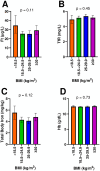Iron status and anemia in a representative sample of US pregnant women is not associated with pre-pregnancy BMI: Results from the NHANES (1999-2010) study
- PMID: 39255312
- PMCID: PMC11386453
- DOI: 10.1371/journal.pone.0300912
Iron status and anemia in a representative sample of US pregnant women is not associated with pre-pregnancy BMI: Results from the NHANES (1999-2010) study
Abstract
Iron deficiency in pregnancy is related to many poor health outcomes, including anemia and low birth weight. A small number of previous studies have identified maternal body mass index (BMI) as a potential risk factor for poor iron status. Our objective was to examine the association between pre-pregnancy BMI, iron status, and anemia in a nationally representative sample of US adult women. We used data from the National Health and Nutrition Examination Survey (NHANES; 1999-2010) for pregnant women ages 18-49 years (n = 1156). BMI (kg/m2) was calculated using pre-pregnancy weight (self-reported) and height (measured at examination). Iron deficiency (ID) was defined as total body iron (calculated from serum ferritin and transferrin receptor using Cook's equation) < 0 mg/kg and anemia as hemoglobin < 11 g/dL. Associations were examined using weighted linear and Poisson regression models, adjusted for confounders (age, race/ethnicity, education, and trimester). Approximately 14% of pregnant women had ID and 8% had anemia in this sample. Ferritin and total body iron trended slightly lower (p = 0.12, p = 0.14) in women with pre-pregnancy BMI in the normal and overweight categories compared to the underweight and obese categories; hemoglobin concentrations were similar across BMI groups (p = 0.76). There were no differences in the prevalence of ID or anemia in women with pre-pregnancy overweight and obesity (ID: overweight, adjusted prevalence ratio (PR) = 1.27, 95%CI: 0.89-1.82; obesity, PR = 0.75, 95%CI: 0.39-1.45; anemia: overweight, PR = 1.08, 95%CI: 0.53-2.19; obesity, PR = 0.99, 95%CI: 0.49-2.01) compared to women with a normal BMI. Findings from these US nationally representative data indicate that total body iron, serum hemoglobin, ID, and anemia in pregnancy do not differ by pre-pregnancy BMI. Since ID and anemia during pregnancy remain significant public health concerns, NHANES should consider measuring current iron status in upcoming cycles.
Copyright: © 2024 Ciulei et al. This is an open access article distributed under the terms of the Creative Commons Attribution License, which permits unrestricted use, distribution, and reproduction in any medium, provided the original author and source are credited.
Conflict of interest statement
The authors have declared that no competing interests exist.
Figures

References
MeSH terms
Substances
LinkOut - more resources
Full Text Sources
Medical
Research Materials

